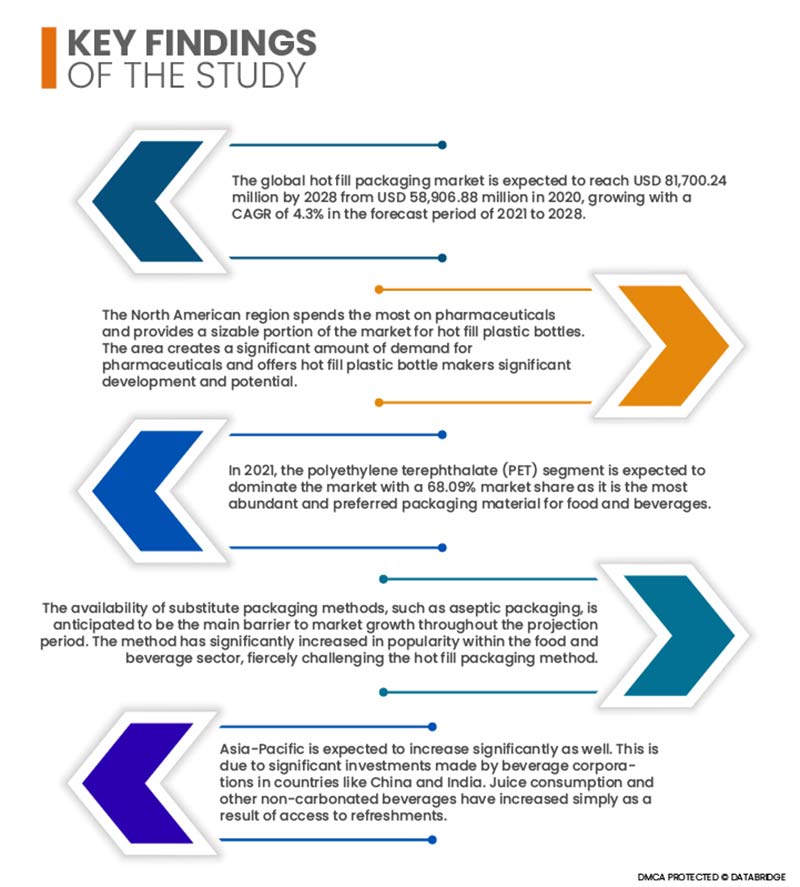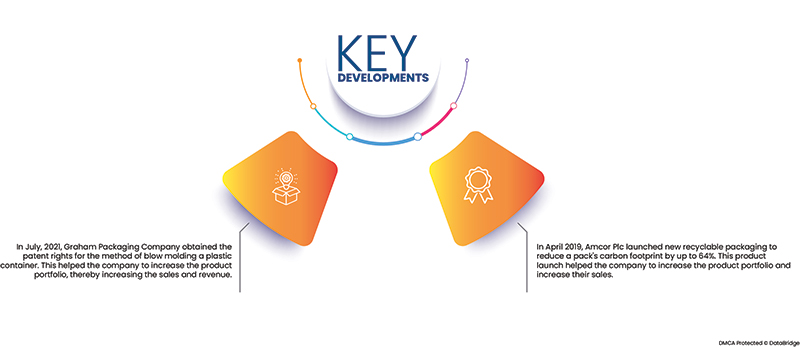Чтобы предотвратить загрязнение продукта, жидкость нагревают до температуры 194 градуса по Фаренгейту для получения пластиковых бутылок горячего розлива. Горячий розлив — это процесс, в котором используется стекло или другой прочный пластик, который может выдерживать высокие температуры, необходимые для полной стерилизации контейнера, содержащего предметы с pH 4,5, такие как изотонические напитки, супы, маринады и соки, среди прочего. Бутылки из ПЭТ выдерживают тепло, необходимое для горячего розлива, не деформируясь и не разрушаясь, в отличие от стеклянных бутылок, которые часто используются для этой операции.
Доступ к полному отчету по адресу https://www.databridgemarketresearch.com/reports/global-hot-fill-packaging-market
Ожидается, что мировой рынок упаковки для горячего розлива достигнет 81 700,24 млн долларов США к 2028 году с 58 906,88 млн долларов США в 2020 году, увеличившись с среднегодовым темпом роста 4,3% в прогнозируемый период с 2021 по 2028 год. Хорошая упаковка необходима для распространения вакцин и флаконов. Прочные флаконы, которые не вступают в химическую реакцию с раствором вакцины, являются обязательными. Пластиковые бутылки с горячим розливом необходимы для фармацевтических продуктов, поскольку они должны как можно меньше взаимодействовать с химическими веществами. Кроме того, ожидается, что количество потребляемых во всем мире продуктов питания и напитков значительно возрастет. Во всем мире потребляется больше готовой к употреблению пищи, чем когда-либо прежде, а напитки в пластиковых бутылках для горячего розлива не требуют консервантов, что делает их полезными для здоровья.

Рост спроса среди потребителей на продукты без консервантов будет способствовать темпам роста рынка.
Растущий спрос потребителей по всему миру на продукты без консервантов является ключевым фактором для мирового рынка упаковки горячего розлива. Поскольку потребители все больше беспокоятся о вредном воздействии консервантов в своих напитках, спрос на продукты без консервантов находится на пике. Это стимулирует рост рынка. Увеличение расходов государственных и частных игроков на развитие инфраструктуры также будет способствовать темпам роста рынка. Постоянные исследования и разработки, касающиеся внедрения передовых технологий, снова расширят сферу роста.
Область отчета и сегментация рынка
Отчет Метрика
|
Подробности
|
Прогнозируемый период
|
2021-2028
|
Базовый год
|
2020
|
Исторические годы
|
2019 (Можно настроить на 2013 - 2018)
|
Количественные единицы
|
Доход в млн. долл. США, объемы в единицах, цены в долл. США
|
Охваченные сегменты
|
Тип продукта (бутылки, банки, контейнеры, пакеты, банки, крышки и укупорочные средства и другие), тип материала ( полиэтилентерефталат (ПЭТ), стекло, полипропилен и другие), упаковочный слой (первичный, вторичный и третичный), емкость (до 12 унций, 13 унций - 32 унции, 33 унции - 64 унции, более 64 унций, 13 унций - 32 унции), тип машины (ручная и автоматическая), конечный пользователь (соусы и спреды, фруктовые соки, овощные соки, джемы, майонез, ароматизированная вода, готовые к употреблению напитки, супы, молочные продукты, нектары и другие), канал распространения (офлайн и онлайн)
|
Страны, охваченные
|
США, Канада и Мексика в Северной Америке, Германия, Франция, Великобритания, Нидерланды, Швейцария, Бельгия, Россия, Италия, Испания, Турция, Остальная Европа в Европе, Китай, Япония, Индия, Южная Корея, Сингапур, Малайзия, Австралия, Таиланд, Индонезия, Филиппины, Остальная часть Азиатско-Тихоокеанского региона (APAC) в Азиатско-Тихоокеанском регионе (APAC), Саудовская Аравия, ОАЭ, Южная Африка, Египет, Израиль, Остальной Ближний Восток и Африка (MEA) как часть Ближнего Востока и Африки (MEA), Бразилия, Аргентина и Остальная часть Южной Америки как часть Южной Америки.
|
Охваченные участники рынка
|
United States Plastic Corporation (США), Berry Global Inc. (США), Imperial Packaging (США), DS Smith (Великобритания), Samkin Industries (Индия), Smurfit Kappa (Ирландия), RESILUX NV (Бельгия), SAMYANG PACKAGING CORPORATION (Южная Корея), MJS Packaging (США), Gualapack SpA (Италия), E-proPLAST GmbH (Германия), LOG Plastic Products Company Ltd. (Венгрия), Klöckner Pentaplast (Люксембург), Kaufman Container (США), Pipeline Packaging (США), Amcor plc (Австралия), Graham Packaging Company (США) и Borealis AG (Австрия) и другие.
|
Данные, отраженные в отчете
|
Помимо таких рыночных данных, как рыночная стоимость, темпы роста, сегменты рынка, географический охват, участники рынка и рыночный сценарий, рыночный отчет, подготовленный командой Data Bridge Market Research, включает в себя углубленный экспертный анализ, анализ импорта/экспорта, анализ цен, анализ потребления продукции, патентный анализ и технологические достижения.
|
Анализ сегмента:
Мировой рынок упаковки для горячего розлива делится на семь сегментов в зависимости от типа продукта, типа машины, типа материала, производительности, слоя упаковки, канала сбыта и конечного использования.
- На основе типа продукта рынок упаковки для горячего розлива сегментируется на бутылки, банки, контейнеры, пакеты, банки, крышки и крышки и т. д. Ожидается, что в 2021 году сегмент бутылок будет доминировать на рынке с долей рынка 59,50% из-за большого объема производства и простоты использования упаковки для бутылок.
- По типу материала рынок упаковки для горячего розлива сегментируется на полиэтилентерефталат (ПЭТ), стекло, полипропилен (ПП) и др. Ожидается, что в 2021 году сегмент полиэтилентерефталата (ПЭТ) будет доминировать на рынке с долей рынка 68,09%, поскольку это самый распространенный и предпочтительный упаковочный материал для продуктов питания и напитков.
- На основе слоев упаковки рынок упаковки для горячего розлива в 2021 году будет сегментирован на первичный, вторичный и третичный. Ожидается, что первичный сегмент будет доминировать на рынке с долей рынка 70,45%, поскольку первичным является тот слой упаковки, который напрямую контактирует с продуктом.
- На основе емкости рынок упаковки горячего розлива сегментируется на до 12 унций, 13 унций - 32 унции, 33 унции - 64 унции и более 64 унций. Ожидается, что в 2021 году сегмент 13 унций - 32 унции будет доминировать на рынке с долей рынка 73,36%, поскольку потребители проявляют большой интерес к размеру упаковки продукта из-за ее доступности.
- На основе типа машины рынок упаковки горячего розлива сегментируется на автоматический и ручной. Ожидается, что в 2021 году автоматический сегмент будет доминировать на рынке с долей рынка 70,99%, поскольку он обеспечивает массовое производство упаковки и снижает вероятность заражения через контакт с человеком.
- На основе канала дистрибуции рынок упаковки горячего розлива сегментируется на онлайн и офлайн. Ожидается, что в 2021 году офлайн-сегмент будет доминировать на рынке с долей рынка 82,94% из-за обширной сети распространения офлайн-канала.
Автономный сегмент будет доминировать в сегменте каналов дистрибуции на рынке упаковки для горячего розлива.
Офлайн-сегмент станет доминирующим сегментом в сегменте каналов дистрибуции в 2021 году. Это связано с растущим числом локальных и офлайн-ритейлеров по всему миру. Кроме того, рост и расширение услуг по научно-исследовательским разработкам в глобальном масштабе еще больше поддержит рост этого сегмента.
- На основе конечного использования рынок упаковки для горячего розлива сегментируется на соусы и спреды, фруктовые соки, овощные соки, джемы, майонез, ароматизированную воду, готовые к употреблению напитки, супы, молочные продукты, нектары и др. Ожидается, что в 2021 году сегмент фруктовых соков будет доминировать на рынке с долей рынка 64,01%, поскольку упаковка для горячего розлива фруктовых соков снижает вероятность микробного заражения.
Сегмент фруктовых соков будет доминировать в сегменте конечного использования на рынке упаковки для горячего розлива.
Сегмент фруктовых соков станет доминирующим сегментом по конечному использованию в 2021 году с долей рынка около 64%. Это связано с растущей осведомленностью о пользе фруктовых соков для здоровья на рынке, особенно в развивающихся экономиках. Кроме того, рост и расширение индустрии продуктов питания и напитков по всему миру еще больше поддержит рост этого сегмента.

Основные игроки
Data Bridge Market Research выделяет следующие компании в качестве игроков на рынке упаковки для горячего розлива: United States Plastic Corporation (США), Berry Global Inc. (США), Imperial Packaging (США), DS Smith (Великобритания), Smurfit Kappa (Ирландия), RESILUX NV (Бельгия), SAMYANG PACKAGING CORPORATION (Южная Корея), MJS Packaging (США), Gualapack SpA (Италия), E-proPLAST GmbH (Германия), Pipeline Packaging (США), Amcor plc (Австралия), Graham Packaging Company (США) и Borealis AG (Австрия).
вставить изображение 2
Развитие рынка
- В июле 2021 года компания Graham Packaging Company получила патентные права на метод выдувного формования пластикового контейнера. Это помогло компании расширить портфель продукции, увеличив продажи и выручку.
- В апреле 2019 года Amcor Plc запустила новую перерабатываемую упаковку, чтобы сократить углеродный след упаковки до 64%. Этот запуск продукта помог компании расширить свой ассортимент продукции и объем продаж.
Региональный анализ
Географически в отчете о рынке упаковки для горячего розлива рассматриваются следующие страны: США, Канада и Мексика в Северной Америке, Германия, Франция, Великобритания, Нидерланды, Швейцария, Бельгия, Россия, Италия, Испания, Турция, остальные страны Европы в Европе, Китай, Япония, Индия, Южная Корея, Сингапур, Малайзия, Австралия, Таиланд, Индонезия, Филиппины, остальные страны Азиатско-Тихоокеанского региона (APAC) в Азиатско-Тихоокеанском регионе (APAC), Саудовская Аравия, ОАЭ, Южная Африка, Египет, Израиль, остальные страны Ближнего Востока и Африки (MEA) как часть Ближнего Востока и Африки (MEA), Бразилия, Аргентина и остальные страны Южной Америки как часть Южной Америки.
Согласно анализу Data Bridge Market Research:
Северная Америка будет доминирующим регионом на рынке упаковки для горячего розлива в прогнозируемый период 2021–2028 гг.
Североамериканский регион тратит больше всего на фармацевтические препараты и обеспечивает значительную часть рынка пластиковых бутылок для горячего розлива. Этот регион создает значительный спрос на фармацевтические препараты и предлагает производителям пластиковых бутылок для горячего розлива значительное развитие и потенциал. При этом продажа пластиковых бутылок для горячего розлива значительно возросла в тандеме с расширением сектора продуктов питания и напитков.
По оценкам, Азиатско-Тихоокеанский регион станет самым быстрорастущим регионом на рынке упаковки для горячего розлива в прогнозируемый период 2021–2028 гг.
Ожидается, что Азиатско-Тихоокеанский регион также значительно увеличится и зарегистрирует самые высокие темпы роста из-за значительных инвестиций, сделанных корпорациями по производству напитков в таких странах, как Китай и Индия. Потребление соков и других негазированных напитков увеличилось просто в результате доступа к прохладительным напиткам. В результате индустрия напитков быстро растет, что, вероятно, увеличит спрос на упаковку для горячего розлива в течение всего прогнозируемого периода.
Факторы, препятствующие темпам роста рынка
Ожидается, что наличие альтернативных методов упаковки, таких как асептическая упаковка, станет основным препятствием для роста рынка в течение прогнозируемого периода. Этот метод значительно возрос в популярности в секторе продуктов питания и напитков, что серьезно оспаривает метод упаковки горячего розлива. Кроме того, прогнозируется, что высокое энергопотребление упаковки горячего розлива во всем мире снизит продажи. Для горячего розлива необходимы тяжелые дорогие бутылки. Для горячего розлива учитываются ПЭТ-бутылки весом 24 г против 16 г. Кроме того, это может изменить то, как вкусы пищи и как мягкие питательные вещества будут затронуты. Из-за вышеупомянутых проблем прогнозируется, что продажи упаковки горячего розлива пострадают. Однако преимущества рынка уравновесят недостатки и помогут увеличить продажи упаковки горячего розлива.
Для получения более подробной информации об отчете о рынке упаковки горячего розлива нажмите здесь – https://www.databridgemarketresearch.com/reports/global-hot-fill-packaging-market










